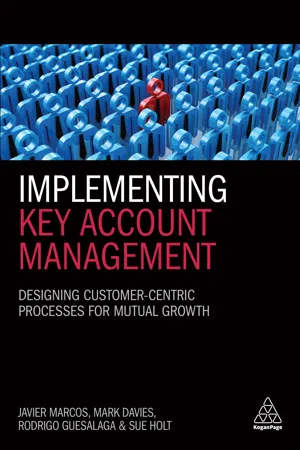
Implementing Key Account Management
Designing Customer-Centric Processes for Mutual Growth
- English
- ePUB (mobile friendly)
- Available on iOS & Android
Implementing Key Account Management
Designing Customer-Centric Processes for Mutual Growth
About this book
Implementing Key Account Management is a highly practical handbook that guides readers through the realities of rolling out a functional key account management programme. The book offers an integrated framework for key account management (KAM) that businesses can use to design or further develop strategic customer management programmes, enabling them to overcome the obstacles that organizations often face when rolling out their strategies.
Bringing together the experiences of leading experts within this field, Implementing Key Account Management draws on two decades of research and best practice from Cranfield University School of Management, one of the foremost centres for researcher and thought leadership in KAM. Between them, the authors have designed and delivered programmes globally for clients such as Rolls-Royce, Unilever, Vodafone, The Economist and many more. Rigorously researched, well-grounded and practical, this book is - quite simply - the definitive, go-to resource for implementing key account management programmes.
Frequently asked questions
- Essential is ideal for learners and professionals who enjoy exploring a wide range of subjects. Access the Essential Library with 800,000+ trusted titles and best-sellers across business, personal growth, and the humanities. Includes unlimited reading time and Standard Read Aloud voice.
- Complete: Perfect for advanced learners and researchers needing full, unrestricted access. Unlock 1.4M+ books across hundreds of subjects, including academic and specialized titles. The Complete Plan also includes advanced features like Premium Read Aloud and Research Assistant.
Please note we cannot support devices running on iOS 13 and Android 7 or earlier. Learn more about using the app.
Information
PART ONE
Re-engaging strategic customers
02
Adopting key account management
Overview
The need for KAM
- the allocation of dedicated personnel to a key account, usually a key account manager (KAMgr) and a cross-functional team;
- training and skills development for customer-facing executives;
- the commitment of senior management time;
- the design of tailored products, services and solutions;
- the adoption of new technologies and communication channels.
- developing a customer-centric culture;
- designing a new organizational structure;
- establishing new communication channels among functional areas;
- redefining performance metrics to incorporate customer-related aspects.
- To what extent is our business concentrated on a few customers?
- To what extent do our customers require a KAM approach?
- To what extent can we create competitive advantages and differentiate through KAM?
Our business concentrates on a few accounts
Table of contents
- Cover
- Title Page
- Copyright
- Dedication
- Contents
- List of Figures
- List of Tables
- About the author
- Preface
- Acknowledgements
- 01 Introduction to implementing key account management
- PART ONE Re-engaging strategic customers
- PART TWO Developing winning offerings
- PART THREE Designing customer-centric approaches and processes
- PART FOUR Assessing your KAM programme: a framework
- Epilogue: Final word on implementing KAM from a global practitioner at Unilever Food Solutions
- Index
- Backcover
